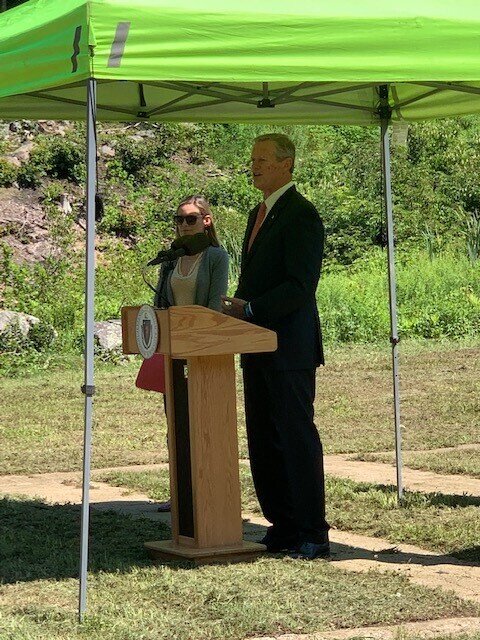Traveling full-circle through time
Photo of Sylvy’s Place Road sawmill. Date unknown. Click here to view excerpt from chapter “The History of Kingston.”
By Skip Stuck, Key Volunteer
What got me so excited about Stewart/Person Preserve? It's not one of the Trust's high-profile showcase preserves. Although beautiful, it's not a place of unique natural history. Stewart/Person is a small preserve, located on Sylvia Place Road in Kingston. However, its 27 acres hold a rich human history and perhaps an even more interesting future. Although small, it has an outsized history, from wilderness through several phases of development, and soon, maybe back to wilderness again. Few preserves illustrate this cycle better.
As you read this, I challenge you to think about what Stewart/Person Preserve looked like during each of its historical phases, and what it might look like ten years from now.
As always, a reminder that this account is far from comprehensive. A goal of this project is to start a conversation with the Wildlands community about the cultural pasts of our cherished natural spaces. If you or someone you know has information about Stewart/Person Preserve’s history, we would love to hear from you! Share your insight (and/or photos!) with Communications Coordinator Thomas Patti at tpatti@wildlandstrust.org.
Early History
20,000 years ago, at the height of the last ice age, this area was covered by a glacier, perhaps 1,000 feet thick. As the ice melted, the current topography of low, pine-covered, flat-topped hills and valleys was created out of the gravel, sand, and stone left behind. The valleys held wetlands like streams, small ponds, and bogs.
By 9,000 years ago, evidence shows that there were Native American people living here, at a time when the climate was similar to that found in northern Quebec today. These people thrived as the climate warmed, and by the time the Pilgrims arrived in 1620, the land was occupied by the Patuxet members of the Wampanoag Tribe. Like many local tribes at the time, the Patuxet population was reeling from a smallpox epidemic brought by Europeans several years prior.
1975 letter from Wildlands Trust co-founder and president Kathleen Anderson to Gertrude H. and O. Wellington Stewart after the Stewarts donated their 13-acre Kingston property. Click here to enlarge.
1600s and 1700s
While the Native people valued the area’s abundance of game, water, and timber, colonial settlers quickly focused on the water flowing down from the surrounding hills. Early on, iron deposits—or "bog iron"—were discovered and mined. Trees were cut down to produce the charcoal to fire furnaces and forges. But by the mid-1700s, the colonists realized that a supply of falling water was all that was needed to turn the machinery. Soon the brooks were dammed, and dams on the Stewart/Person property (plus several more downstream) created three bodies of water: Russell, Sylvia Place (sometimes called Sylvy's), and Bryant Mill ponds. In the winter, ice was harvested from the ponds. Powered by water, area factories producing cannon balls, tacks, and shoes came to be known as "Millgate." These lasted well into the 1800s. Crumbling foundations of these establishments are still visible today.
Over the years, other mills produced iron, flour, and lumber all the way down to the Jones River and eventually to Kingston Bay. On occasion, an earthen dam along this chain would breach, damaging homes and other mills downstream.
The dams dramatically altered the natural landscape, as well. In the place of historic bogs emerged ponds lined with second-growth forests of pine, oak, alder, and red maple—reflective of the Stewart/Person we see today.
1800s and 1900s
The need for water power decreased in the 1800s as oil and eventually gas and electricity took over. Factories, no longer requiring hydropower, moved on from the area. Old dams continued to degrade. In 1930, a fish ladder was built by the federal Works Progress Administration to provide an avenue for herring and other migratory fish to spawn on their historic runs. The land was becoming a quiet place once again.
In 1975, O. Wellington and Gertrude H. Stewart donated 13.3 acres to Wildlands Trust. In 2011, Martin B. and Joan Person donated an adjoining 13.48 acres, thus creating Stewart/Person Preserve. Wildlands built and maintained hiking trails, water crossings, and bridges at what has become a popular recreational destination.
Kingston village map from 1870. Click here to view excerpt from chapter “The History of Kingston.”
2000s: Completing the circle
In the early 2000s, the Trust, Town of Kingston, and state realized that the eroding earthen dams and fish ladders presented an increasing danger to houses, roads, and businesses downstream. With their original purpose gone, it was decided that they needed to be removed. In 2021, Wildlands was ordered to remove the fish ladder and breach the dam on Sylvia Place Pond. In July 2021, the Trust received a state grant of $729,000 to complete the work. Wildlands is working with engineers and permitting agencies to plan, design, and permit the project, which is expected to be started soon.
So, like many places in Southeastern Massachusetts, Stewart/Person Preserve will complete a full circle. From hilly woodlands and boggy bottoms, through 250 years of intensive use and reshaping through industrialization, the property will soon revert to something closer to where it started—a wild land.
Learn more
To learn more about the natural and human history of Stewart/Person Preserve, please visit soon to see how the land looks today, and plan to visit again in the coming years to track its fascinating future. Also, examine some of the following resources:
Our online property description: wildlandstrust.org/stewartperson-preserve
North and South Rivers Watershed Association: nsrwa.org/listing/stewart-person-preserve/
"The O.W. Stewart Preserve," Wildlands Trust, 1973, with additional notes by Reed Stewart, 1993.
“The History of Kingston.” Source unknown. View two-page excerpt here.
“Trust Preserves Wild Areas in Plymouth County.” Anne Bartlett, The Patriot Ledger. 1985.
“Wilder Times in Mill Gate.” Robert Knox, Old Colony Memorial. Nov. 8, 1990.




